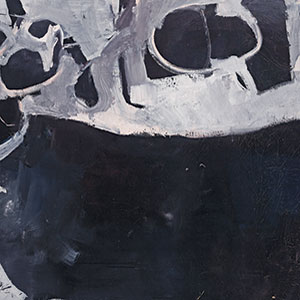Arts
Stanford Explores Diebenkorn
 FILTHY PIG: In Richard Diebenkorn's 'Disintegrating Pig,' an ashen, messy gray background swirls around a distorted swine.
FILTHY PIG: In Richard Diebenkorn's 'Disintegrating Pig,' an ashen, messy gray background swirls around a distorted swine.
Two of Stanford University's museums are devoting this curatorial season to one of their most celebrated alumni, artist Richard Diebenkorn (d. 1993). On Sep. 20, two of his paintings will be on display in "Left of Center: Five Years of the Anderson Collection at Stanford University," an exhibit devoted to West Coast artists. His Girl on the Beach (1957) and Ocean Park #60 (1973) will represent the artist's approaches to figurative and abstract painting.
Concurrently, at the Cantor Arts Center next door, there's "Richard Diebenkorn at the Cantor," which opened on Sep. 4. Both could be thought of as an amuse-bouche rather than the kind of bountiful buffets that career retrospectives tend to proffer to a certain set of museum-goers.
But non-museum-goers can also participate in all things Diebenkornian. Interactive and online components of "Richard Diebenkorn at the Cantor" include The Sketchbooks Revealed and a technological experiment in sleuthing in regard to his 1967 painting Window.
Diebenkorn's wife Phyllis (d. 2015) donated 29 of her husband's sketchbooks to the Cantor, the contents of which have all been scanned to become an everlasting digital record of his works in progress and his thought processes. With 39 drawings, Sketchbook #16 is full of oddities like a pear and a halved banana, above yet another banana, being ignored by a robed figure with their back to the beckoning fruit. The artist plays with these shapes to experiment with shadows made of cross-hatching. There are also several sketches of an overcoat hanging on a wire, a model in a state of repose and a dog's head.
Diebenkorn painted a series of work from interior rooms that look out onto gnomic, geometrically arranged landscapes. In the 92 inch tall Window, an empty folding chair gazes at a red clay courtyard and a series of mismatched, whitewashed houses. The painting has also been scanned and uploaded for viewing on a monitor that hangs to its left.
This independent project by the engineering physics major Katherine Van Kirk trained an infrared camera on Window. Beneath the painting's finished surface, she discovered several previous incarnations of the work. You can scroll back and forth on Window to see what ghostly objects still linger there faintly disguised, such as a pair of glasses and a naked torso.
To give us a sense of who the man was, the curators installed a large black and white photograph of the mustached artist. Sporting a freshly pressed checked shirt with the sleeves rolled up to his elbows, the photographer captures Diebenkorn in profile looking out onto what must be one of his peaceful and unpeopled courtyards. Apart from his winsome expression, it reveals next to nothing about him. The photo hangs in the round on the top floor of the Oshman Family Gallery rotunda, along with a handful of other canvases.
The subject of one of them, an early painting titled Disintegrating Pig (1950), is a portrait of a black pig that's so fat it can barely hold its shape together. An ashen, messy gray background swirls around its distorted body like a gritty, polluted storm. The palette has more in common with a Franz Kline than it does with Diebenkorn's Ocean Park series.
Ocean Park #60 at the Anderson contains colliding panels of pale blues and wintry greens, while #94, made three years later, confines a rectangle of three different blue hues to the top quarter of the canvas. The rest of the painting is a wash of variously influenced taupes—colors contained within a cloud that's about to burst. Architectural lines come to the foreground. A roofline and the outline of an open doorway peer through the murkiness.
In this series, Diebenkorn remakes the visible world by condensing and collaging their various components. He merges the pastoral and urban impulses of a place in flux. The buildings and vistas are recognizable but from a hazy distance. Diebenkorn looks at the landscape from above, and as it cycles through time. Tangible, manmade objects blur until they become unreal. These paintings are a record of one neighborhood in Los Angeles, and of his ardor for the distinctive light that shines in Californian skies.
Richard Diebenkorn at the Cantor
Ongoing, Free
Cantor Arts Center, Stanford
museum.stanford.edu
Left of Center
Thru Sep 20, 2020, Free
Anderson Collection at Stanford University
anderson.stanford.edu


